ECO mode HONDA PASSPORT 2001 2.G Owners Manual
[x] Cancel search | Manufacturer: HONDA, Model Year: 2001, Model line: PASSPORT, Model: HONDA PASSPORT 2001 2.GPages: 317, PDF Size: 4.85 MB
Page 8 of 317
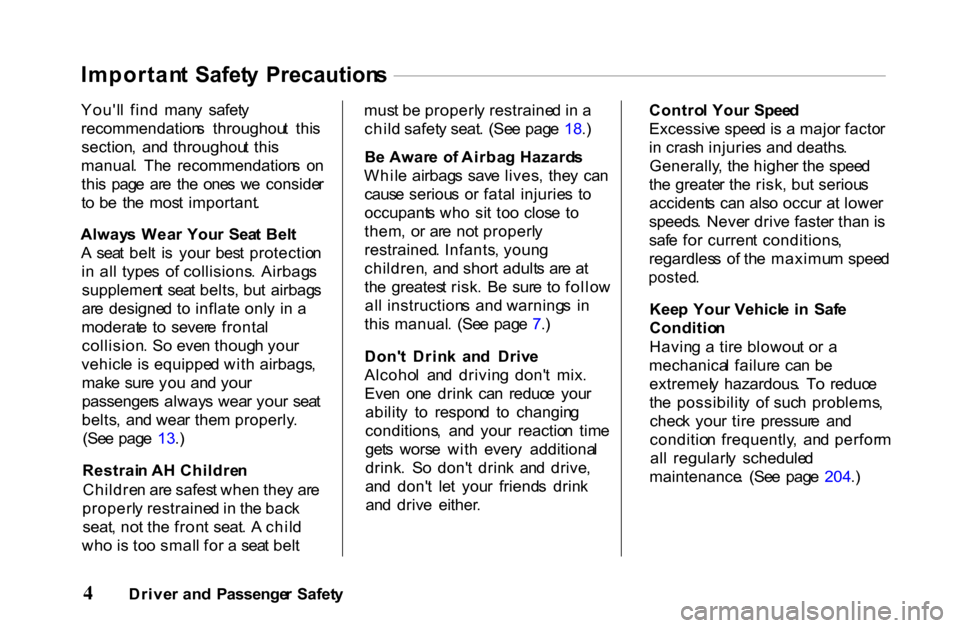
Importan
t Safet y Precaution s
You'l l fin d man y safet y
recommendation s throughou t thi s
section , an d throughou t thi s
manual . Th e recommendation s o n
thi s pag e ar e th e one s w e conside r
t o b e th e mos t important .
Alway s Wea r You r Sea t Bel t
A sea t bel t i s you r bes t protectio n
i n al l type s o f collisions . Airbag s
supplemen t sea t belts , bu t airbag s
ar e designe d t o inflat e onl y i n a
moderat e t o sever e fronta l
collision . S o eve n thoug h you r
vehicl e i s equippe d wit h airbags ,
mak e sur e yo u an d you r
passenger s alway s wea r you r sea t
belts , an d wea r the m properly .
(Se e pag e 13 .)
Restrai n A H Childre n
Childre n ar e safes t whe n the y ar e
properl y restraine d in th e bac k
seat , no t th e fron t seat . A chil d
wh o is to o smal l fo r a sea t bel t mus
t b e properl y restraine d in a
chil d safet y seat . (Se e pag e 18 .)
B e Awar e o f Airba g Hazard s
Whil e airbag s sav e lives , the y ca n
caus e seriou s o r fata l injurie s t o
occupant s wh o si t to o clos e t o
them , o r ar e no t properl y
restrained . Infants , youn g
children , an d shor t adult s ar e a t
th e greates t risk . B e sur e t o follo w
al l instruction s and warning s i n
thi s manual . (Se e pag e 7 .)
Don' t Drin k an d Driv e
Alcoho l an d drivin g don' t mix .
Eve n on e drin k ca n reduc e you r
abilit y t o respon d t o changin g
conditions , an d you r reactio n tim e
get s wors e wit h ever y additiona l
drink . S o don' t drin k an d drive ,
an d don' t le t you r friend s drin k
an d driv e either . Contro
l You r Spee d
Excessiv e spee d is a majo r facto r
i n cras h injurie s an d deaths .
Generally , th e highe r th e spee d
th e greate r th e risk , bu t seriou s
accident s ca n als o occu r a t lowe r
speeds . Neve r driv e faste r tha n is
saf e fo r curren t conditions ,
regardles s o f th e maximu m spee d
posted .
Kee p You r Vehicl e i n Saf e
Conditio n
Havin g a tir e blowou t o r a
mechanica l failur e ca n b e
extremel y hazardous . T o reduc e
th e possibilit y o f suc h problems ,
chec k you r tir e pressur e an d
conditio n frequently , an d perfor m
al l regularl y schedule d
maintenance . (Se e pag e 204 .)
Drive r an d Passenge r Safet y
Page 23 of 317
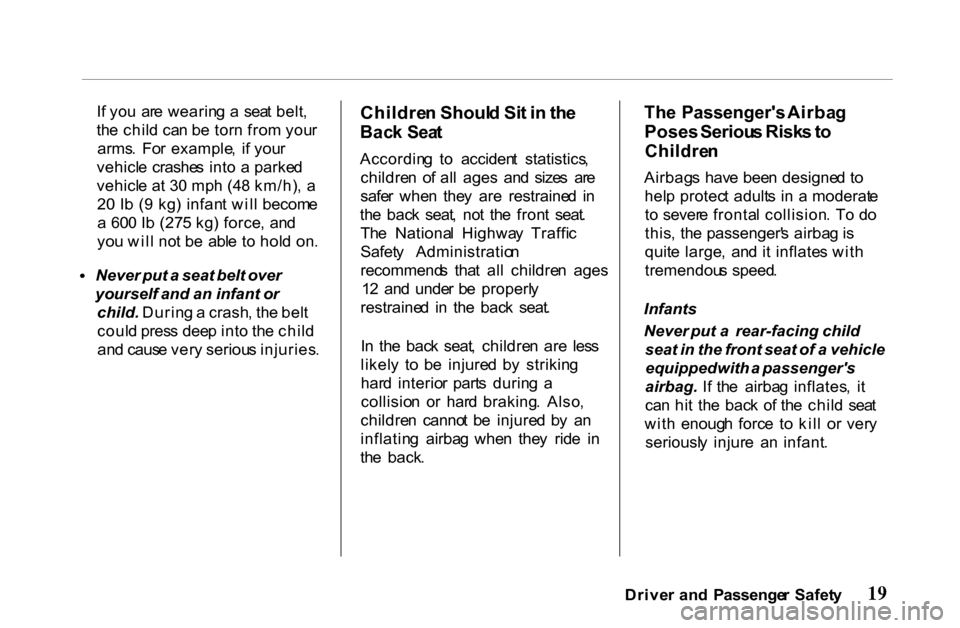
I
f yo u ar e wearin g a sea t belt ,
th e chil d ca n b e tor n fro m you r
arms . Fo r example , i f you r
vehicl e crashe s int o a parke d
vehicl e a t 3 0 mp h (4 8 km/h) , a
2 0 I b ( 9 kg ) infan t wil l becom e
a 60 0 I b (27 5 kg ) force , an d
yo u wil l no t b e abl e t o hol d on . Never
put a seat belt over
yourself and an infant or
child. Durin g a crash , th e bel t
coul d pres s dee p int o th e chil d
an d caus e ver y seriou s injuries .Childre
n Shoul d Si t i n th e
Bac k Sea t
Accordin g t o acciden t statistics ,
childre n o f al l ages and size s ar e
safe r whe n the y are restraine d i n
th e bac k seat , no t th e fron t seat .
Th e Nationa l Highwa y Traffi c
Safet y Administratio n
recommend s tha t al l childre n ages
1 2 an d unde r b e properl y
restraine d i n th e bac k seat .
I n th e bac k seat , childre n are les s
likel y t o b e injure d b y strikin g
har d interio r part s durin g a
collisio n o r har d braking . Also ,
childre n canno t b e injure d b y a n
inflatin g airba g whe n the y rid e i n
th e back .
Th
e Passenger's Airbag
Poses Seriou s Risk s to
Childre n
Airbag s hav e bee n designe d t o
hel p protec t adult s i n a moderat e
t o sever e fronta l collision . T o d o
this , th e passenger' s airba g is
quit e large , an d i t inflate s wit h
tremendou s speed .
Infants
Never put a rear-facing child
seat in the front seat of a vehicle
equipped with a passenger's
airbag. If th e airba g inflates , i t
ca n hi t th e bac k o f th e chil d sea t
wit h enoug h forc e t o kil l o r ver y
seriousl y injur e a n infant .
Drive r an d Passenge r Safet y
Page 27 of 317
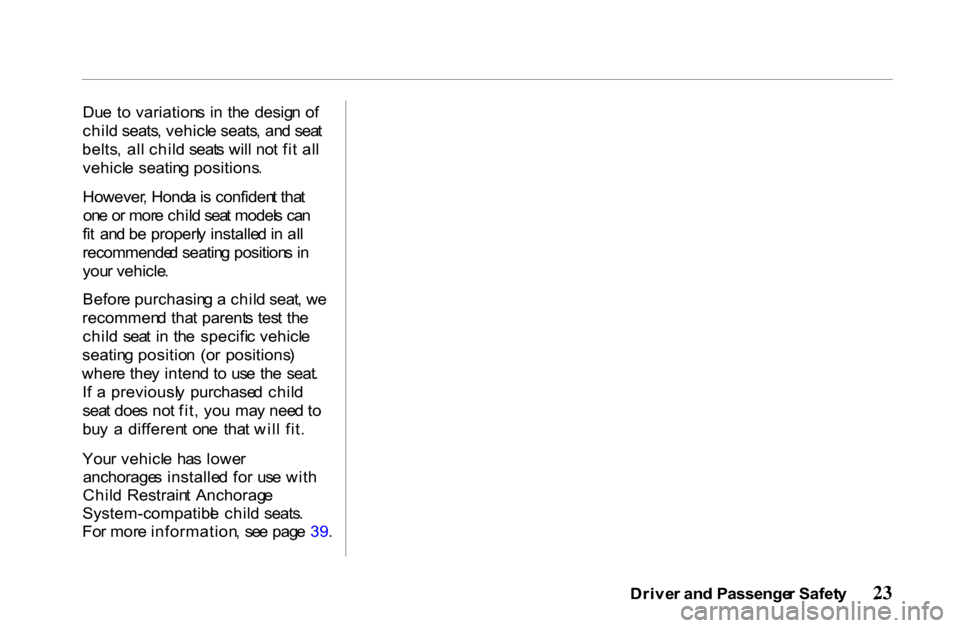
Du
e t o variation s i n th e desig n o f
chil d seats , vehicl e seats , an d sea t
belts , al l chil d seat s will no t fi t al l
vehicl e seatin g positions .
However , Hond a is confiden t tha t
on e o r mor e chil d sea t model s ca n
fi t an d b e properl y installe d in al l
recommende d seatin g position s in
you r vehicle .
Befor e purchasin g a chil d seat , w e
recommen d tha t parent s tes t th e
chil d sea t i n th e specifi c vehicl e
seatin g positio n (o r positions )
wher e the y inten d t o us e th e seat .
I f a previousl y purchase d chil d
sea t doe s no t fit , yo u ma y nee d to
bu y a differen t on e tha t wil l fit .
You r vehicl e ha s lowe r
anchorage s installe d fo r us e wit h
Chil d Restrain t Anchorag e
System-compatibl e chil d seats .
Fo r mor e information , se e pag e 39 .
Driver an d Passenge r Safet y
Page 30 of 317
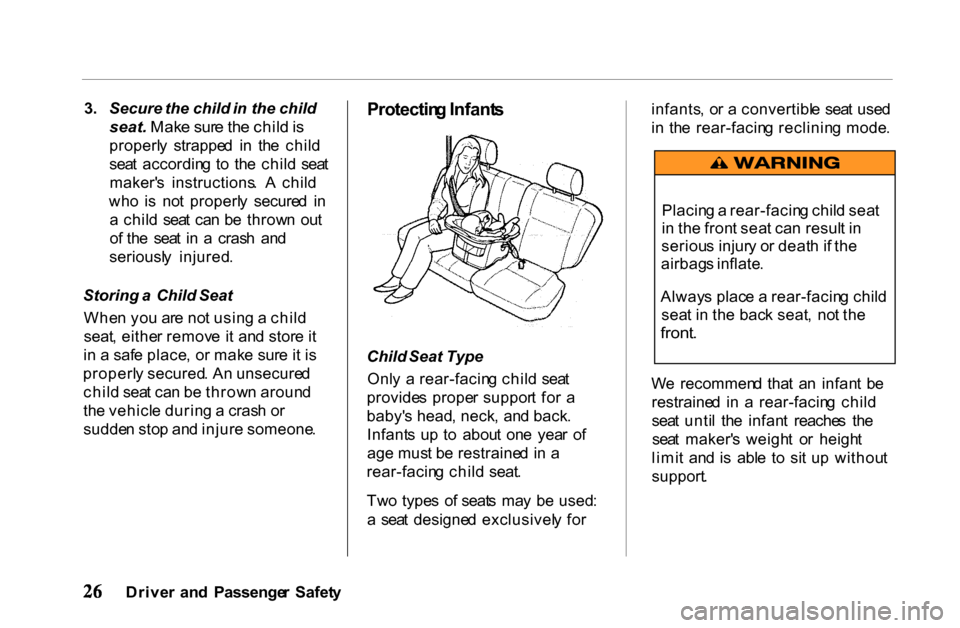
3
. Secure the child in the child
seat. Make sur e th e chil d is
properl y strappe d i n th e chil d
sea t accordin g t o th e chil d sea t
maker' s instructions . A chil d
wh o i s no t properl y secure d i n
a chil d sea t ca n b e throw n ou t
o f th e sea t i n a cras h an d
seriousl y injured .
Storing a Child Seat
Whe n yo u ar e no t usin g a chil d
seat , eithe r remov e i t an d stor e it
i n a saf e place , o r mak e sur e it i s
properl y secured . A n unsecure d
chil d sea t ca n b e throw n aroun d
th e vehicl e durin g a cras h o r
sudde n sto p an d injur e someone .
Protectin
g Infant s
Child Seat Type
Onl y a rear-facin g chil d sea t
provide s prope r suppor t fo r a
baby' s head , neck , an d back .
Infant s u p t o abou t on e yea r o f
age mus t b e restraine d i n a
rear-facin g chil d seat .
Tw o type s o f seat s ma y b e used :
a sea t designe d exclusivel y fo r infants
, o r a convertibl e sea t use d
i n th e rear-facin g reclinin g mode .
W e recommen d tha t a n infan t b e
restraine d i n a rear-facin g chil d
sea t unti l th e infan t reache s th e
sea t maker' s weigh t o r heigh t
limi t an d i s abl e t o si t u p withou t
support .
Drive r an d Passenge r Safet y Placin
g a rear-facin g chil d sea t
i n th e fron t sea t ca n resul t i n
seriou s injur y o r deat h if th e
airbag s inflate .
Alway s plac e a rear-facin g chil d
sea t i n th e bac k seat , no t th e
front .
Page 71 of 317
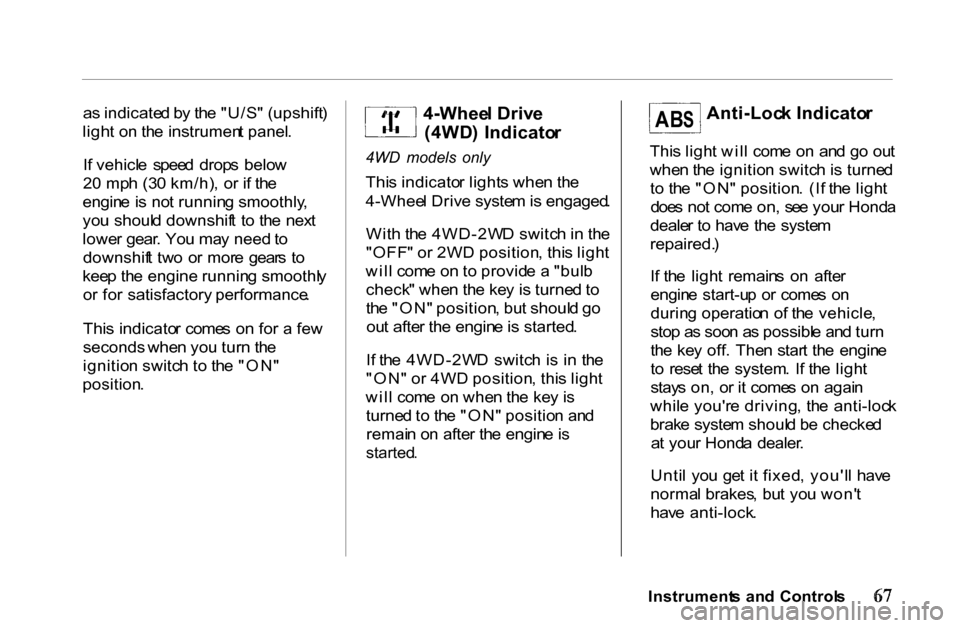
a
s indicate d b y th e "U/S " (upshift )
ligh t o n th e instrumen t panel .
I f vehicl e spee d drop s belo w
2 0 mp h (3 0 km/h) , o r i f th e
engin e is no t runnin g smoothly ,
yo u shoul d downshif t t o th e nex t
lowe r gear . Yo u ma y need to
downshif t tw o o r mor e gear s t o
kee p th e engine runnin g smoothl y
o r fo r satisfactory performance .
Thi s indicato r come s o n fo r a fe w
seconds when yo u tur n th e
ignitio n switc h t o th e "ON "
position .
4-Whee
l Driv e
(4WD ) Indicato r
4WD models only
Thi s indicato r light s whe n th e
4-Whee l Driv e syste m is engaged .
Wit h th e 4WD-2W D switc h in th e
"OFF " o r 2W D position , thi s ligh t
wil l com e o n t o provid e a "bul b
check " whe n th e ke y i s turne d to
th e "ON " position , bu t shoul d g o
ou t afte r th e engin e is started .
I f th e 4WD-2W D switc h i s i n th e
"ON " o r 4W D position , thi s ligh t
wil l com e o n whe n th e ke y i s
turne d to th e "ON " positio n an d
remai n o n afte r th e engin e is
started .
Anti-Loc
k Indicato r
Thi s ligh t wil l com e o n an d g o ou t
whe n th e ignitio n switc h is turne d
t o th e "ON " position . (I f th e ligh t
doe s no t com e on , se e you r Hond a
deale r t o hav e th e syste m
repaired. )
I f th e ligh t remain s o n afte r
engin e start-u p o r come s o n
durin g operatio n o f th e vehicle ,
sto p a s soo n a s possibl e an d tur n
th e ke y off . The n star t th e engin e
t o rese t th e system . I f th e ligh t
stay s on , o r i t come s o n agai n
whil e you'r e driving , th e anti-loc k
brak e syste m shoul d b e checke d
a t you r Hond a dealer .
Unti l yo u ge t i t fixed , you'l l hav e
norma l brakes , bu t yo u won' t
hav e anti-lock .
Instrument s an d Control s
ABS
Page 72 of 317
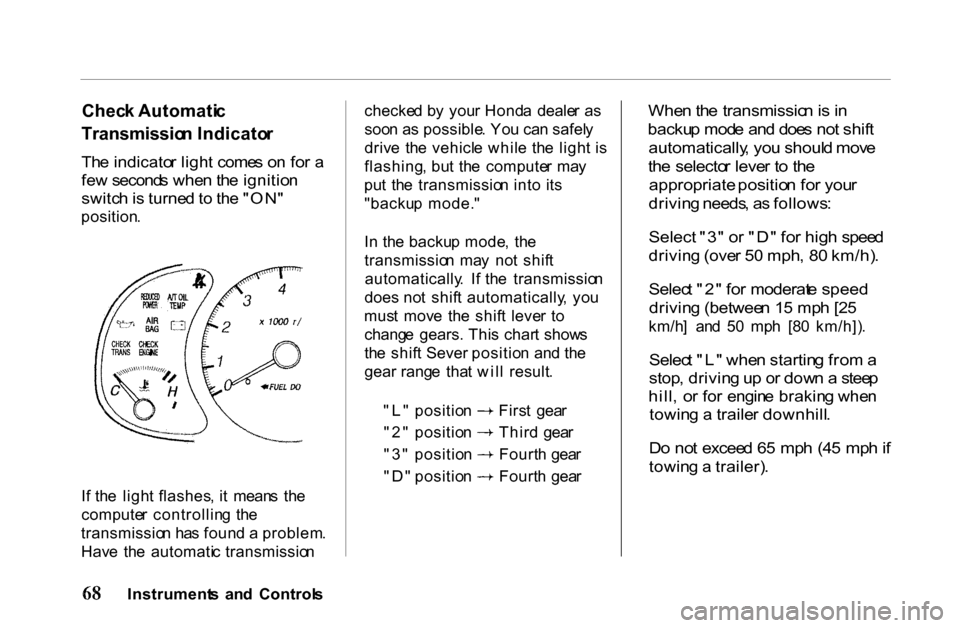
Chec
k Automati c
Transmissio n Indicato r
Th e indicato r ligh t come s o n fo r a
fe w second s whe n th e ignitio n
switc h is turne d to th e "ON "
position .
I f th e ligh t flashes , i t mean s th e
compute r controllin g th e
transmissio n ha s foun d a problem .
Hav e th e automati c transmissio nchecke
d b y you r Hond a deale r a s
soo n a s possible . Yo u ca n safel y
driv e th e vehicl e whil e th e ligh t i s
flashing , bu t th e compute r ma y
pu t th e transmissio n int o it s
"backu p mode. "
I n th e backu p mode , th e
transmissio n ma y no t shif t
automatically . I f th e transmissio n
does not shif t automatically , yo u
mus t mov e th e shif t leve r t o
chang e gears. This char t show s
th e shif t Sever positio n an d th e
gear rang e tha t wil l result . "L
" positio n Firs t gea r "2
" positio n Thir d gea r "3
" positio n Fourt h gea r "D
" positio n Fourt h gea r
Whe
n th e transmissio n is i n
backu p mod e an d doe s no t shif t
automatically , yo u shoul d mov e
th e selecto r leve r t o th e
appropriate position fo r you r
drivin g needs , a s follows :
Select "3" o r "D " fo r hig h spee d
drivin g (ove r 5 0 mph , 8 0 km/h) .
Selec t "2 " fo r moderat e speed
drivin g (betwee n 1 5 mp h [2 5
km/h ] an d 5 0 mp h [8 0 km/h]) .
Selec t "L " whe n startin g fro m a
stop , drivin g u p o r dow n a stee p
hill , o r fo r engin e brakin g whe n
towin g a traile r downhill .
D o no t excee d 6 5 mp h (4 5 mp h if
towin g a trailer) .
Instrument s an d Control s
Page 81 of 317
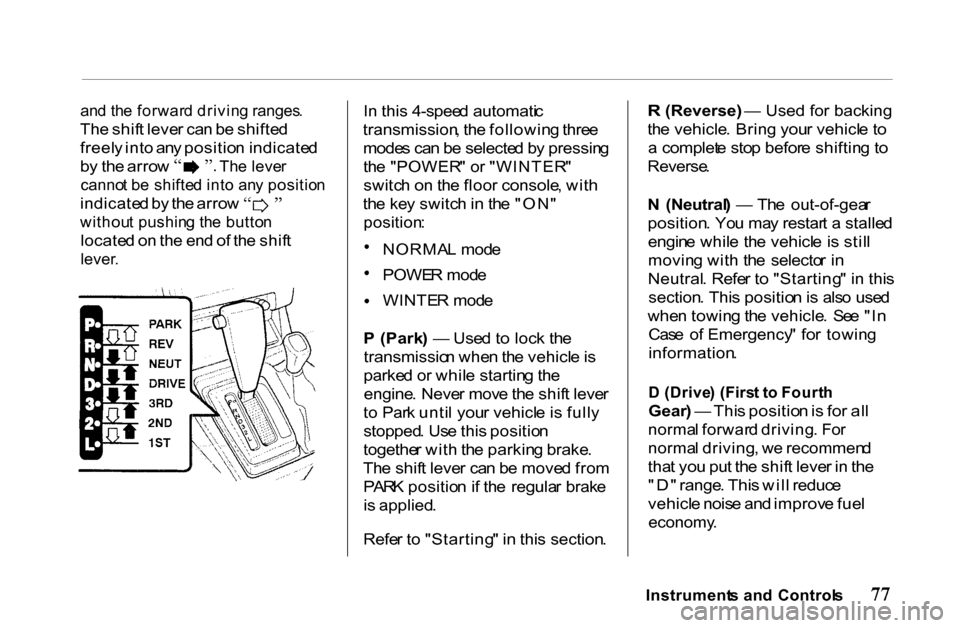
an
d th e forwar d drivin g ranges .
Th e shif t leve r ca n b e shifte d
freel y int o an y positio n indicate d b
y th e arro w
Th e leve r
canno t b e shifte d int o an y positio n
indicate
d b y th e arro w
withou t pushin g th e butto n
locate d o n th e en d o f th e shif t
lever .
I
n this 4-spee d automati c
transmission , th e followin g thre e
mode s ca n b e selecte d b y pressin g
th e "POWER " o r "WINTER "
switc h o n th e floo r console , wit h
th e ke y switc h in th e "ON "
position :
NORMA
L mod e POWE
R mod e WINTE
R mod e
P (Park ) — Use d t o loc k th e
transmissio n whe n th e vehicl e is
parke d o r whil e startin g th e
engine . Neve r mov e th e shif t leve r
t o Par k unti l you r vehicl e is full y
stopped . Us e this positio n
togethe r wit h th e parkin g brake .
Th e shif t leve r ca n b e move d fro m
PAR K positio n if th e regula r brak e
i s applied .
Refe r t o "Starting " i n thi s section .
R (Reverse) — Used for backing
the vehicle . Brin g you r vehicl e t o
a complet e sto p befor e shiftin g to
Reverse .
N (Neutral ) — Th e out-of-gea r
position . Yo u ma y restar t a stalle d
engin e whil e th e vehicl e is stil l
movin g wit h th e selecto r i n
Neutral . Refe r t o "Starting " i n thi s
section . Thi s positio n is als o use d
whe n towin g th e vehicle . Se e "I n
Cas e o f Emergency " fo r towin g
information .
D (Drive ) (Firs t t o Fourt h
Gear ) — Thi s positio n is fo r al l
norma l forwar d driving . Fo r
norma l driving , w e recommen d
tha t yo u pu t th e shif t leve r i n th e
"D " range . Thi s wil l reduc e
vehicl e nois e an d improv e fue l
economy .
Instrument s an d Control s
Page 82 of 317
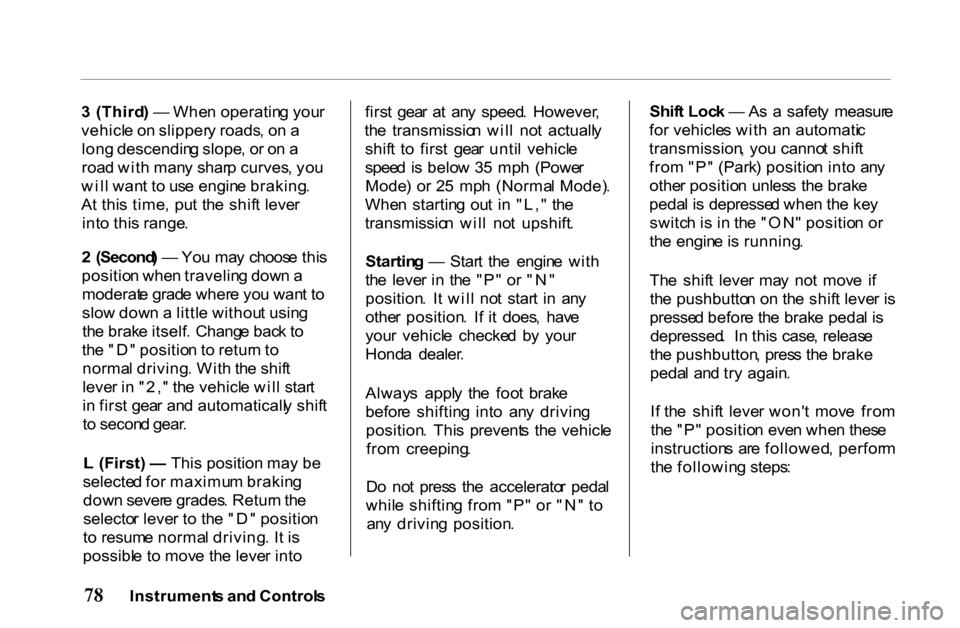
3
(Third ) — Whe n operatin g you r
vehicl e o n slipper y roads , o n a
lon g descendin g slope , o r o n a
roa d wit h man y shar p curves , yo u
wil l wan t t o us e engin e braking .
A t thi s time , pu t th e shif t leve r
int o thi s range .
2 (Second ) — Yo u ma y choos e thi s
positio n whe n travelin g dow n a
moderat e grad e wher e yo u wan t t o
slo w dow n a littl e withou t usin g
th e brak e itself . Chang e bac k t o
th e "D " positio n to retur n to
norma l driving . Wit h th e shif t
leve r i n "2, " th e vehicl e wil l star t
i n firs t gea r an d automaticall y shif t
t o secon d gear .
L (First) — This position may be
selecte d fo r maximu m brakin g
dow n sever e grades . Retur n th e
selecto r leve r t o th e "D " positio n
t o resum e norma l driving . I t i s
possibl e t o mov e th e leve r int o firs
t gea r a t an y speed . However ,
th e transmissio n wil l no t actuall y
shif t t o firs t gea r unti l vehicl e
spee d is belo w 3 5 mp h (Powe r
Mode ) o r 2 5 mp h (Norma l Mode) .
Whe n startin g ou t i n "L, " th e
transmissio n wil l no t upshift .
Startin g — Star t th e engin e wit h
th e leve r i n th e "P " o r "N "
position . I t wil l no t star t i n an y
othe r position . I f i t does , hav e
you r vehicl e checke d b y you r
Hond a dealer .
Alway s appl y th e foo t brak e
befor e shiftin g int o an y drivin g
position . Thi s prevent s th e vehicl e
fro m creeping .
D o no t pres s th e accelerato r peda l
whil e shiftin g fro m "P " o r "N " t o
an y drivin g position . Shif
t Loc k — As a safet y measur e
fo r vehicle s wit h a n automati c
transmission , yo u canno t shif t
fro m "P " (Park ) positio n int o an y
othe r positio n unles s th e brak e
peda l i s depresse d whe n th e ke y
switc h is i n th e "ON " positio n o r
th e engin e is running .
Th e shif t leve r ma y no t mov e i f
th e pushbutto n o n th e shif t leve r i s
presse d befor e th e brak e peda l i s
depressed . I n thi s case , releas e
th e pushbutton , pres s th e brake
peda l an d tr y again .
I f th e shif t leve r won' t mov e fro m
th e "P " positio n eve n whe n thes e
instruction s ar e followed , perfor m
th e followin g steps :
Instrument s an d Control s
Page 84 of 317
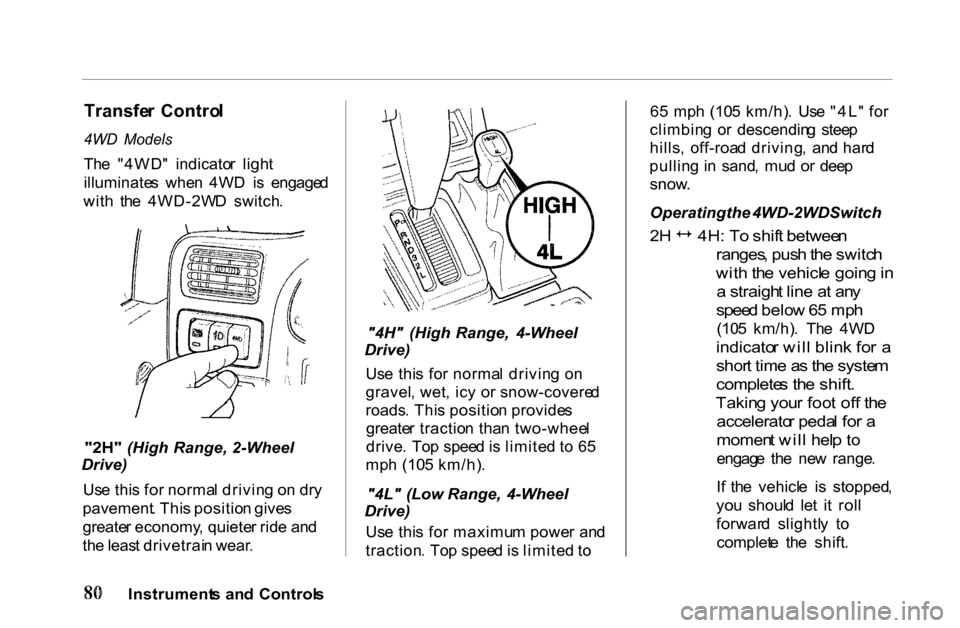
Transfe
r Contro l
4WD Models
Th e "4WD " indicato r ligh t
illuminate s whe n 4W D i s engage d
wit h th e 4WD-2W D switch .
"2H" (High Range, 2-Wheel
Drive)
Us e thi s fo r norma l drivin g o n dr y
pavement . Thi s positio n give s
greate r economy , quiete r rid e an d
th e leas t drivetrai n wear . "4H"
(High Range, 4-Wheel
Drive)
Us e thi s fo r norma l drivin g o n
gravel , wet , ic y o r snow-covere d
roads . Thi s positio n provide s
greate r tractio n tha n two-whee l
drive . To p spee d is limite d t o 6 5
mp h (10 5 km/h) .
"4L" (Low Range, 4-Wheel
Drive)
Us e thi s fo r maximu m powe r an d
traction . To p spee d is limite d t o 6
5 mp h (10 5 km/h) . Us e "4L " fo r
climbin g o r descendin g stee p
hills , off-roa d driving , an d har d
pullin g i n sand , mu d o r dee p
snow .
Operating the 4WD-2WD Switch
2
H 4H : T o shif t betwee n
ranges , pus h th e switc h
wit h th e vehicl e goin g in
a straigh t lin e a t an y
spee d belo w 6 5 mp h
(10 5 km/h) . Th e 4W D
indicato r wil l blin k fo r a
shor t tim e a s th e syste m
complete s th e shift .
Takin g you r foo t of f th e
accelerato r peda l fo r a
momen t wil l hel p t o
engag e th e ne w range .
I f th e vehicl e i s stopped ,
yo u shoul d le t i t rol l
forwar d slightl y t o
complet e th e shift .
Instrument s an d Control s
Page 88 of 317
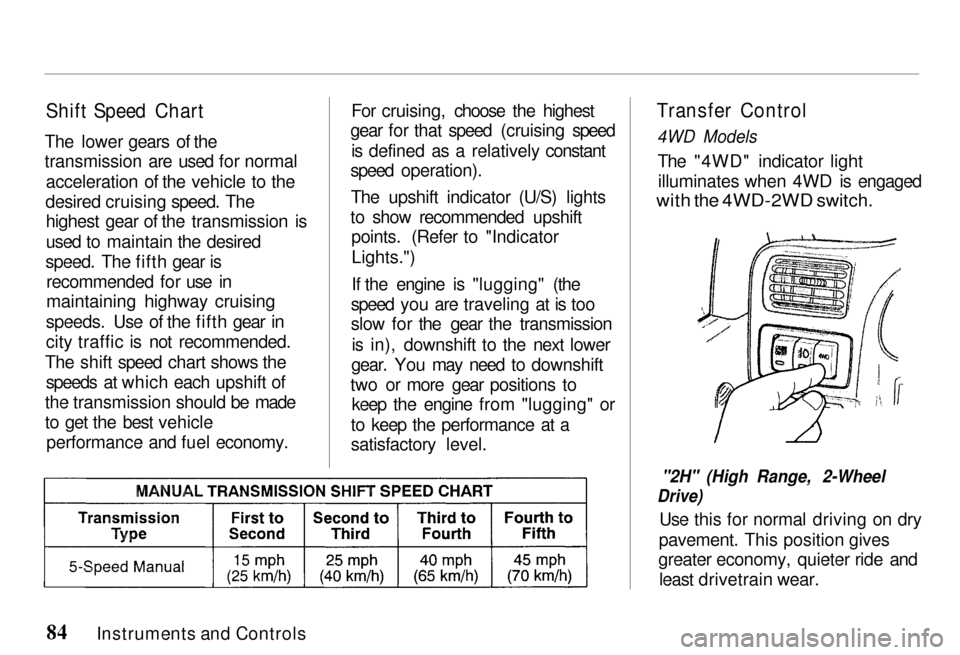
Shift Speed Chart
The lower gears of the
transmission are used for normal
acceleration of
the vehicle to the
desired cruising
speed. The
highest gear of the transmission is
used to maintain the desired
speed. The
fifth gear is
recommended for
use in
maintaining highway cruising
speeds. Use of the fifth gear in
city traffic
is not recommended.
The shif
t speed chart shows the
speeds a
t which each upshift of
the transmission
should be made
to get the best vehicle performance and
fuel economy. For cruising,
choose the highest
gear for
that speed (cruising speed
is defined as a relatively constant
speed operation).
Th
e upshift indicator (U/S) lights
to show recommended upshift points. (Refer
to "Indicator
Lights.")
If th
e engine is "lugging" (the
speed you are traveling at is too
slow for the gear the transmission
is in),
downshift to the next lower
gear. You
may need to downshift
two or more gear positions to keep the engine from "lugging" or
to keep the performance at a
satisfactory level.
Transfe
r Control
4WD Models
The "4WD" indicator lightilluminates when
4WD is engaged
with the 4WD-2WD switch.
"2H" (High Range, 2-Wheel
Drive)
Us
e this for normal driving on dry
pavement. This
position gives
greater economy, quieter ride and
least drivetrain
wear.
Instruments and Controls